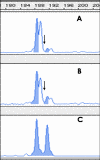Carcinosarcoma of the colon: report of a case with morphological, ultrastructural and molecular analysis
- PMID: 16836749
- PMCID: PMC1570146
- DOI: 10.1186/1471-2407-6-185
Carcinosarcoma of the colon: report of a case with morphological, ultrastructural and molecular analysis
Abstract
Background: Carcinosarcoma of the colon is a rare histopathological entity with uncertain histogenesis, that shows both epithelial and mesenchymal malignant differentiation. Carcinosarcoma rarely affects the gastrointestinal tract and only few cases are reported in the colon. Herein we describe a carcinosarcoma of the ascending colon, with morphological, ultrastructural and molecular analysis.
Case presentation: An 81-year-old man was hospitalised for asthenia, weight loss and iron-deficiency anaemia. The patient underwent colonoscopy and adenocarcinoma was diagnosed by endoscopic biopsy. A right hemicolectomy was performed and, during surgical operation, liver metastases were detected. Histological examination of the surgical specimen revealed areas of both carcinomatous and sarcomatous differentiation, completely separated by fibrous septae. The sarcomatous component exhibited areas of smooth muscle and osteoblastic differentiation, with focal osteoid material deposition. Molecular analysis conducted separately on the epithelial and mesenchymal components revealed the same p53 gene mutation (R282W in exon 8) and identical polymorphisms in p53 exon 4, in EGFR exons 20 and 21, and in c-kit exon 17. Microsatellite markers analysis revealed a common loss of heterozygosis on 18q. Overall, the data are consistent with a common origin of the two tumor components. The patient was treated with 8 cycles of oral capecitabine (1250 mg/m2 twice a day for 14 days repeated every 28 days) and two years after surgery is alive with liver metastases.
Conclusion: Carcinosarcoma of the colon is a rare tumour with both epithelial and sarcomatous components. Molecular analysis of the current case suggests the histogenesis from a common cell progenitor.
Figures






Similar articles
-
Esophageal carcinosarcoma with basaloid squamous carcinoma and rhabdomyosarcoma components with TP53 mutation.Pathol Int. 2004 Oct;54(10):803-9. doi: 10.1111/j.1440-1827.2004.01759.x. Pathol Int. 2004. PMID: 15482572
-
Carcinosarcoma of the uterus: immunohistochemical and genetic analysis of clonality of one case.Gynecol Oncol. 2001 Sep;82(3):563-7. doi: 10.1006/gyno.2001.6307. Gynecol Oncol. 2001. PMID: 11520156
-
Primary cutaneous carcinosarcoma: insights into its clonal origin and mutational pattern expression analysis through next-generation sequencing.Hum Pathol. 2013 Dec;44(12):2853-60. doi: 10.1016/j.humpath.2013.07.014. Epub 2013 Sep 24. Hum Pathol. 2013. PMID: 24071013
-
Carcinosarcoma of the colon: report of a case and review of the literature.J Gastroenterol. 1998 Apr;33(2):276-9. doi: 10.1007/s005350050083. J Gastroenterol. 1998. PMID: 9605962 Review.
-
Skin metastasis from the spindle cell component in rectal carcinosarcoma.Hepatogastroenterology. 2000 Nov-Dec;47(36):1611-4. Hepatogastroenterology. 2000. PMID: 11149014 Review.
Cited by
-
Carcinosarcoma in the cecum.Gut Liver. 2012 Jul;6(3):395-8. doi: 10.5009/gnl.2012.6.3.395. Epub 2012 Jul 12. Gut Liver. 2012. PMID: 22844571 Free PMC article.
-
Carcinosarcoma on ascending colon found by bowel perforation: a case report.J Korean Soc Coloproctol. 2010 Oct;26(5):368-72. doi: 10.3393/jksc.2010.26.5.368. Epub 2010 Oct 31. J Korean Soc Coloproctol. 2010. PMID: 21152142 Free PMC article.
-
The significance of the site of origin in primary peritoneal carcinosarcoma: case report and literature review.Ecancermedicalscience. 2013 Mar 7;7:295. doi: 10.3332/ecancer.2013.295. Print 2013. Ecancermedicalscience. 2013. PMID: 23589725 Free PMC article.
-
Carcinosarcoma of the Rectum: Report of a Rare Colorectal Malignancy and Review of the Literature.Case Rep Surg. 2015;2015:412918. doi: 10.1155/2015/412918. Epub 2015 Nov 17. Case Rep Surg. 2015. PMID: 26664813 Free PMC article.
-
An Unconventional Regimen of Carboplatin and Paclitaxel in Metastatic Colorectal Carcinosarcoma: A Case Report and Review of Literature.Curr Oncol. 2023 May 10;30(5):4897-4903. doi: 10.3390/curroncol30050369. Curr Oncol. 2023. PMID: 37232827 Free PMC article. Review.
References
-
- Wick MR, Swanson PE. Carcinosarcomas: current perspectives and an histological review of nosological concepts. Semin Diagn Pathol. 1993;10:118–127. - PubMed
-
- Iezzoni JC, Mills SE. Sarcomatoid carcinomas (carcinosarcomas) of the gastrointestinal tract: a review. Semin Diagn Pathol. 1993;10:176–187. - PubMed
-
- Twelves C, Wong A, Nowacki MP, Abt M, Burris H, 3rd, Carrato A, Cassidy J, Cervantes A, Fagerberg J, Georgoulias V, Husseini F, Jodrell D, Koralewski P, Kroning H, Maroun J, Marschner N, McKendrick J, Pawlicki M, Rosso R, Schuller J, Seitz JF, Stabuc B, Tujakowski J, Van Hazel G, Zaluski J, Scheithauer W. Capecitabine as adjuvant treatment for stage III colon cancer. N Engl J Med. 2005;352:2696–704. doi: 10.1056/NEJMoa043116. - DOI - PubMed
-
- Lynch TJ, Bell DW, Sordella R, Gurubhagavatula S, Okimoto RA, Brannigan BW, Harris PL, Haserlat SM, Supko JG, Haluska FG, Louis DN, Christiani DC, Settleman J, Haber DA. Activating Mutations in the Epidermal Growth Factor Receptor Underlying Responsiveness of Non-Small-Cell Lung Cancer to Gefitinib. N Engl J Med. 2004;350:2129–2139. doi: 10.1056/NEJMoa040938. - DOI - PubMed
Publication types
MeSH terms
LinkOut - more resources
Full Text Sources
Research Materials
Miscellaneous

